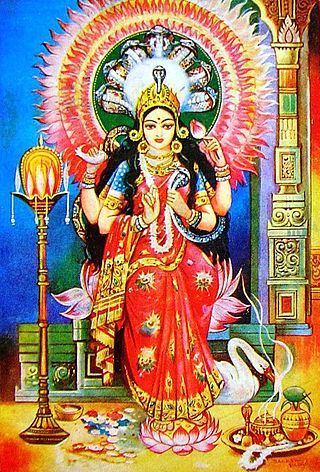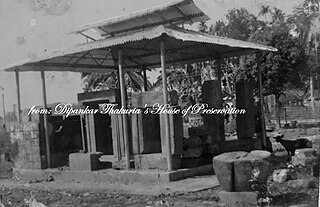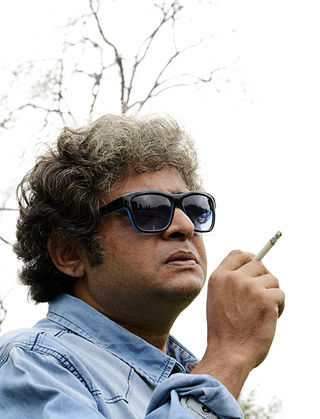
Pohela Boishakh ) is the Bengali New Year celebrated on 14 April in Bangladesh and 15 April in the Indian states of West Bengal, Tripura, Jharkhand and Assam. It is a festival based on the spring harvest—which marks the first day of the new year in the official calendar of Bangladesh.

Behula is a protagonist in the Manasamangal genre of Assamese and Bengali medieval epics. A number of works belonging to this genre were written between the thirteenth and eighteenth centuries. Though the religious purpose of these works is to eulogise the Hindu goddess Manasa, these works are more well known for depicting the love story of Behula and her husband Lakhindar.

Chandi or Chandika is a Hindu deity. Chandika is another form of Mahadevi, similar to Durga. Chandika is a powerful form of Mahadevi who manifested to destroy evil. She is also known as Kaushiki, Katyayani, AsthadasabujaMahalakshmi and Mahishasuramardini.

Jatra is a popular folk-theatre form Bengali theatre, spread throughout most of Bengali speaking areas of the Indian subcontinent, including Bangladesh and Indian states of West Bengal, Assam, Odisha and Tripura As of 2005, there were some 55 troupes based in Calcutta's old Jatra district, Chitpur Road, and all together, jatra is a $21m-a-year industry, performed on nearly 4,000 stages in West Bengal alone, where in 2001, over 300 companies employed over 20,000 people, more than the local film industry and urban theatre.

Rishra is a city and a municipality in Srirampore subdivision of Hooghly district in the Indian state of West Bengal. It is a part of the area covered by Kolkata Metropolitan Development Authority (KMDA).

Mangal-Kāvya is a group of Bengali religious texts, composed more or less between 13th and 18th centuries, notably consisting of narratives of indigenous deities of rural Bengal in the social scenario of the Middle Ages. The Mangal-Kāvyas usually give prominence to a particular deity amalgamated with a Vedic or Hindu mythological god and the narratives are usually written in the form of verses.
There are several theories about the origin of Kolkata, erstwhile Calcutta in English, the name of the capital of the eastern Indian state of West Bengal.
Pankaj Kumar Gupta was one of the earliest Indian sports administrators involved in professional football, hockey and cricket. He is best known for his involvement in professional hockey where he worked variously as a manager, administrator, and referee. His contributions earned him the nickname "Mr. Hockey". He also became the first head coach of the India national football team in 1938, and guided the team in the Indian tour of Australia.

Manasa is a Hindu goddess of snakes. She is worshipped mainly in Bihar, Bengal, Jharkhand, South Assam and other parts of northeastern India and in Uttarakhand, chiefly for the prevention and cure of snakebite, and also for fertility and prosperity. In Hinduism, Manasa is the sister of Shesha and Vasuki, king of Nāgas (serpents), and wife of sage Jaratkaru. She is the mother of the sage Astika. She is also known as Vishahari, Nityā (eternal) and Padmavati.

Chand Sadagar was an Indian sea merchant of Champaknagar in Eastern India. This merchant has been claimed by both the Assamese and Bengali people of India to be associated with their respective states and communities. Medieval Bengali poet Bipradas Pipilai mentioned in his "Manasamangal Kāvya" that merchant ship of Chand Sadagar used to proceed to the sea from ancient Champaknagar of Kamarupa after passing through Tribeni, situated at the junction of Saptagram and the confluence of Ganges, Saraswati and Jamuna River of modern-day West Bengal. Narayan Dev in the Assamese scriptures gave an account in his Manasamangal about the merchant ship of the trader Chand Saudagar proceeding to the sea from ancient Champaknagar of Assam passing through Saptagram and Tribeni, the tri-junction of the Ganges, Saraswati and Jamuna River. In the Padma Puran, account of Chand Bania (Sadagar) is specifically mentioned.

Manasamangal Kāvya is recognized as the oldest of the Bengali Mangal-Kāvyas, chronicling the establishment of the snake-goddess Manasa's worship in Bengal. Initially, Manasa was worshipped by the Dravidians, who hoped she would safeguard them from snake-related dangers. The goddess holds alternative names such as Bisahari, Janguli, and Padmavati.

Singam (transl. Lion) is a 2010 Indian Tamil-language action film directed by Hari and produced by K. E. Gnanavel Raja under Studio Green in association with Reliance Big Pictures and distributed by Sun Pictures. The film, which is the first installment in the Singam franchise, stars Suriya as the lead role in his 25th film, with Anushka Shetty, Prakash Raj and Vivek in supporting roles.

Hinduism is the largest religious tradition in the Indian state of West Bengal with approximately 70.53% of the population identifying themselves as Hindus. The Hindus in West Bengal mostly belong to the Shakta, minority to Vaishnavite and a small community belong to Shaivite and other denominations. The vast majority of Hindus in West Bengal are Bengali Hindus numbering around 55 million and comprising 60.2% of the state population of 91.35 million (2011) but a notable section of non-Bengali Hindus also exist, particularly among Marwaris, Biharis, Odias, Gurkhas, Sindhis, Gujaratis and various tribal communities such as Koch, Santals, Munda and particularly Adivadis numbering around 9.4 million comprising rest 10.3% of the state population. Hindus have decreased in west bengal due to conversion to Islam which National Commission for Backward Classess(NCBC) notices.
Goutam Halder was an Indian theatre actor and director from Kolkata. He had a graduate degree from Ramakrishna Mission Vivekananda Centenary (V.C.) College, Rahara.
Chandrabati was a medieval Bengali poet, widely considered as the first known female poet of Bengali language. She is best known for her women-centered epic Ramayana.

Debesh Chattopadhyay is an Indian Bengali film & theatre director and actor. He has also acted in a few Bengali films.
Kasba is a village in Galsi I CD block in Bardhaman Sadar North subdivision of Purba Bardhaman district in the Indian state of West Bengal. It is situated 12.7 km away from sub-district headquarters in Galsi. Bardhaman is the district headquarter of Kasba village. As per 2009 stats, Lowapur-Krishnarampur Gram Panchayet is the gram panchayat of Kasba village. Bardhaman is the nearest town to kasba for all major economic activities approximately 45km away.

Behula is a mythological Bengali television serial which was broadcast on GEC Star Jalsha in 2010, weekdays at 9:30pm. It starred Payel Dey, Arka Majumdar, Rimjhim Mitra, Chandrayee Ghosh, Kaushik Chakraborty and Rupanjana Mitra, produced by Shree Venkatesh Films, it is based on the story of Behula and Lakhindar. It has been aired on Star Vijay as a dubbed Tamil show Mangayin Sabatham and on Sahara One as a dubbed Hindi show under the same name. This serial has also been dubbed in Assamese language as Soti Beula and aired on Focus Hifi. It was re-aired on Star Jalsha during lockdown period, due to COVID-19.

Krishnendu Adhikari is an Indian actor, director and producer who primarily works in Bengali theatre and the Bengali Film Industry. He co-founded the Kolkata-based Behala Project Prometheus in 2016, with the aim to revitalise political and movement-based theatre in India.
Vijay Gupta was a 15th-century Bengali poet from Barisal. He was part of a revival of Bengali literature in the late 15th century and early 16th century.












